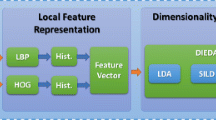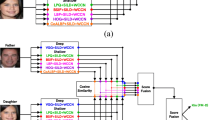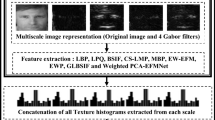Abstract
Side-information based exponential discriminant analysis (SIEDA) is more efficient than side-information based linear discriminant analysis (SILDA) in computing the discriminant vectors because it maximizes the Fisher criterion function. In this paper, we develop a novel criterion, named side-information based weighted exponential discriminant analysis (SIWEDA), that is based on the classical SIEDA method. We reformulate and generalize the classical Fisher criterion function in order to maximize it, with the property to pull as close as possible the intra-class samples (within-class samples), and push and repulse away as far as possible the inter-class samples (between-class samples). Thus, SIWEDA selects the eigenvalues of high significance and eliminate those with less discriminative information. To reduce the feature vector dimensionality and lighten the class intra-variability, we use SIWEDA and within class covariance normalization (WCCN) using the proposed statistical binarized image features (StatBIF). Moreover, we use score fusion strategy to extract the complementarity of different weighting scales of our StatBIF descriptor. We conducted experiments to evaluate the performance of the proposed method under unconstrained environment, using five datasets namely LFW, YTF, Cornell KinFace, UB KinFace and TSKinFace datasets, in the context of matching faces and kinship verification in the wild conditions. The experiments showed that the proposed approach outperforms the current state of the art. Very interestingly, our approach showed superior performance compared to methods based on deep metric learning.





Similar content being viewed by others
References
Arashloo SR, Kittler J (2013) Efficient processing of mrfs for unconstrained-pose face recognition. In: 2013 IEEE sixth international conference on biometrics: theory, applications and systems (BTAS), pp 1–8. https://doi.org/10.1109/BTAS.2013.6712721
Arashloo SR, Kittler J (2014) Class-specific kernel fusion of multiple descriptors for face verification using multiscale binarised statistical image features. IEEE Trans Inf Forensics Secur 9(12):2100–2109. https://doi.org/10.1109/TIFS.2014.2359587
Ayesha S, Hanif MK, Talib R (2020) Overview and comparative study of dimensionality reduction techniques for high dimensional data. Inf Fusion 59:44–58. https://doi.org/10.1016/j.inffus.2020.01.005
Barkan O, Weill J, Wolf L, Aronowitz H (2013) Fast high dimensional vector multiplication face recognition. In: 2013 IEEE international conference on computer vision, pp 1960–1967. https://doi.org/10.1109/ICCV.2013.246
Bekhouche S, Ouafi A, Dornaika F, Taleb-Ahmed A, Hadid A (2017) Pyramid multi-level features for facial demographic estimation. Expert Syst Appl 80:297–310. https://doi.org/10.1016/j.eswa.2017.03.030
Belhumeur PN, Hespanha JP, Kriegman DJ (1997) Eigenfaces vs. fisherfaces: recognition using class specific linear projection. IEEE Trans Pattern Anal Mach Intell 19(7):711–720. https://doi.org/10.1109/34.598228
Best-Rowden L, Bisht S, Klontz JC, Jain AK (2014) Unconstrained face recognition: Establishing baseline human performance via crowdsourcing. In: IEEE International Joint Conference on Biometrics, pp. 1–8 (2014). https://doi.org/10.1109/BTAS.2014.6996296
Chakrabarti A, Rajagopalan AN, Chellappa R (2007) Super-resolution of face images using kernel pca-based prior. IEEE Trans Multimed 9(4):888–892. https://doi.org/10.1109/TMM.2007.893346
Chen D, Cao X, Wen F, Sun J (2013) Blessing of dimensionality: High-dimensional feature and its efficient compression for face verification. In: 2013 IEEE Conference on Computer Vision and Pattern Recognition, pp 3025–3032. https://doi.org/10.1109/CVPR.2013.389
Cui Z, Li W, Xu D, Shan S, Chen X (2013) Fusing robust face region descriptors via multiple metric learning for face recognition in the wild. In: 2013 IEEE Conference on Computer Vision and Pattern Recognition, pp 3554–3561. https://doi.org/10.1109/CVPR.2013.456
Dalal N, Triggs B (2005) Histograms of oriented gradients for human detection. In: 2005 IEEE computer society conference on computer vision and pattern recognition (CVPR’05), vol 1, pp 886–893. https://doi.org/10.1109/CVPR.2005.177
Dehak N, Kenny PJ, Dehak R, Dumouchel P, Ouellet P (2011) Front-end factor analysis for speaker verification. IEEE Trans Audio Speech Lang Process 19(4):788–798. https://doi.org/10.1109/TASL.2010.2064307
Duan Y, Lu J, Feng J, Zhou J (2017) Learning rotation-invariant local binary descriptor. IEEE Trans Image Process 26(8):3636–3651. https://doi.org/10.1109/TIP.2017.2704661
Duan Y, Lu J, Feng J, Zhou J (2018) Context-aware local binary feature learning for face recognition. IEEE Trans Pattern Anal Mach Intell 40(5):1139–1153. https://doi.org/10.1109/TPAMI.2017.2710183
Duan Y, Lu J, Wang Z, Feng J, Zhou J (2017) Learning deep binary descriptor with multi-quantization. In: 2017 IEEE conference on computer vision and pattern recognition (CVPR), pp 4857–4866. https://doi.org/10.1109/CVPR.2017.516
Fang R, Tang KD, Snavely N, Chen T (2010) Towards computational models of kinship verification. In: 2010 IEEE international conference on image processing, pp 1577–1580. https://doi.org/10.1109/ICIP.2010.5652590
Guillaumin M, Verbeek J, Schmid C (2009) Is that you? metric learning approaches for face identification. In: 2009 IEEE 12th international conference on computer vision, pp 498–505. https://doi.org/10.1109/ICCV.2009.5459197
Haghighat M, Abdel-Mottaleb M, Alhalabi W (2016) Fully automatic face normalization and single sample face recognition in unconstrained environments. Expert Syst Appl 47:23–34. https://doi.org/10.1016/j.eswa.2015.10.047
Harrell FE Jr (2015) Regression modeling strategies: with applications to linear models, logistic and ordinal regression, and survival analysis. Springer, Berlin
Hu J, Lu J, Tan Y (2014) Discriminative deep metric learning for face verification in the wild. In: 2014 IEEE conference on computer vision and pattern recognition, pp 1875–1882. https://doi.org/10.1109/CVPR.2014.242
Hu J, Lu J, Yuan J, Tan YP (2014) Large margin multi-metric learning for face and kinship verification in the wild. IEEE Trans Circ Syst Video Technol. https://doi.org/10.1007/978-3-319-16811-1_17
Huang GB, Jain V, Learned-Miller E (2007) Unsupervised joint alignment of complex images. In: 2007 IEEE 11th international conference on computer vision, pp 1–8. https://doi.org/10.1109/ICCV.2007.4408858
Huang GB, Lee H, Learned-Miller E (2012) Learning hierarchical representations for face verification with convolutional deep belief networks. In: 2012 IEEE conference on computer vision and pattern recognition, pp 2518–2525. https://doi.org/10.1109/CVPR.2012.6247968
Huang GB, Ramesh M, Berg T, Learned-Miller E (2007) Labeled faces in the wild: a database for studying face recognition in unconstrained environments. Tech. Rep. 07–49. University of Massachusetts, Amherst
Kannala J, Rahtu E (2012) Bsif: binarized statistical image features. In: Proceedings of the 21st international conference on pattern recognition (ICPR2012), pp 1363–1366
Laiadi O, Ouamane A, Benakcha A, Taleb-Ahmed A, Hadid A (2019) Learning multi-view deep and shallow features through new discriminative subspace for bi-subject and tri-subject kinship verification. Appl Intell 49(11):3894–3908
Laiadi O, Ouamane A, Boutellaa E, Benakcha A, Taleb-Ahmed A, Hadid A (2019) Kinship verification from face images in discriminative subspaces of color components. Multimed Tools Appl 78(12):16465–16487
Li H, Hua G (2015) Hierarchical-pep model for real-world face recognition. In: 2015 IEEE conference on computer vision and pattern recognition (CVPR), pp 4055–4064. https://doi.org/10.1109/CVPR.2015.7299032
Li H, Hua G, Lin Z, Brandt J, Yang J (2013) Probabilistic elastic matching for pose variant face verification. In: 2013 IEEE conference on computer vision and pattern recognition, pp 3499–3506. https://doi.org/10.1109/CVPR.2013.449
Li H, Hua G, Shen X, Lin Z, Brandt J (2015) Eigen-PEP for video face recognition. Springer, Cham, pp 17–33. https://doi.org/10.1007/978-3-319-16811-1_2
Liu C (2014) Discriminant analysis and similarity measure. Pattern Recognit 47(1):359–367. https://doi.org/10.1016/j.patcog.2013.06.023
Lu GF, Wang Y, Zou J, Wang Z (2018) Matrix exponential based discriminant locality preserving projections for feature extraction. Neural Netw 97:127–136. https://doi.org/10.1016/j.neunet.2017.09.014
Lu J, Hu J, Tan YP (2017) Discriminative deep metric learning for face and kinship verification. IEEE Trans Image Process 26(9):4269–4282. https://doi.org/10.1109/TIP.2017.2717505
Lu J, Zhou X, Tan YP, Shang Y, Zhou J (2014) Neighborhood repulsed metric learning for kinship verification. IEEE Trans Pattern Anal Mach Intell 36(2):331–345. https://doi.org/10.1109/TPAMI.2013.134
Mahpod S, Keller Y (2018) Kinship verification using multiview hybrid distance learning. Comput Vis Image Underst 167:28–36. https://doi.org/10.1016/j.cviu.2017.12.003
Mao Q, Rao Q, Yu Y, Dong M (2017) Hierarchical bayesian theme models for multipose facial expression recognition. IEEE Trans Multimed 19(4):861–873. https://doi.org/10.1109/TMM.2016.2629282
Marsico MD, Nappi M, Riccio D, Wechsler H (2013) Robust face recognition for uncontrolled pose and illumination changes. IEEE Trans Syst Man Cybern Syst 43(1):149–163. https://doi.org/10.1109/TSMCA.2012.2192427
Meina K, Shan S, Chen X (2011) Side-information based linear discriminant analysis for face recognition. In: Proc. BMVC, pp 125.1–125.0. https://doi.org/10.5244/C.25.125
Méndez-Váizquez, H., Martínez-Díaz, Y., Chai, Z.: Volume structured ordinal features with background similarity measure for video face recognition. In: 2013 International conference on biometrics (ICB), pp 1–6 (2013). https://doi.org/10.1109/ICB.2013.6612990
Nowak E, Jurie F (2007) Learning visual similarity measures for comparing never seen objects. In: 2007 IEEE conference on computer vision and pattern recognition, pp 1–8. https://doi.org/10.1109/CVPR.2007.382969
Ojala T, Pietikäinen M, Mäenpää T (2002) Multiresolution gray-scale and rotation invariant texture classification with local binary patterns. IEEE Trans Pattern Anal Mach Intell 24(7):971–987. https://doi.org/10.1109/TPAMI.2002.1017623
Ojansivu V, Heikkilä J (2008) Blur insensitive texture classification using local phase quantization. Springer, Berlin, pp 236–243. https://doi.org/10.1007/978-3-540-69905-7_27
Ouamane A, Bengherabi M, Hadid A, Cheriet M (2015) Side-information based exponential discriminant analysis for face verification in the wild. In: 2015 11th IEEE international conference and workshops on automatic face and gesture recognition (FG), vol 02, pp 1–6. https://doi.org/10.1109/FG.2015.7284837
Ouamane A, Chouchane A, Boutellaa E, Belahcene M, Bourennane S, Hadid A (2017) Efficient tensor-based 2d+3d face verification. IEEE Trans Inf Forensics Secur 12(11):2751–2762. https://doi.org/10.1109/TIFS.2017.2718490
Ouamane A, Messaoud B, Guessoum A, Hadid A, Cheriet M (2014) Multi scale multi descriptor local binary features and exponential discriminant analysis for robust face authentication. In: 2014 IEEE international conference on Iimage processing (ICIP), pp 313–317. https://doi.org/10.1109/ICIP.2014.7025062
Pang Y, Wang S, Yuan Y (2014) Learning regularized lda by clustering. IEEE Trans Neural Netw Learn Syst 25(12):2191–2201. https://doi.org/10.1109/TNNLS.2014.2306844
Pinto N, DiCarlo JJ, Cox DD (2009) How far can you get with a modern face recognition test set using only simple features? In: 2009 IEEE conference on computer vision and pattern recognition, pp 2591–2598. https://doi.org/10.1109/CVPR.2009.5206605
Qin X, Liu D, Wang D (2018) Heterogeneous similarity learning for more practical kinship verification. Neural Process Lett 47(3):1253–1269. https://doi.org/10.1007/s11063-017-9694-3
Qin X, Tan X, Chen S (2015) Tri-subject kinship verification: Understanding the core of a family. IEEE Trans Multimed 17(10):1855–1867. https://doi.org/10.1109/TMM.2015.2461462
Raudys SJ, Jain AK (1991) Small sample size effects in statistical pattern recognition: recommendations for practitioners. IEEE Trans Pattern Anal Mach Intell 13(3):252–264. https://doi.org/10.1109/34.75512
Sanderson C, Lovell BC (2009) Multi-region probabilistic histograms for robust and scalable identity Inference. Springer, Berlin, pp 199–208. https://doi.org/10.1007/978-3-642-01793-3_21
Simonyan K, Parkhi OM, Vedaldi A, Zisserman A (2013) Fisher vector faces in the wild. BMVC 2(3):4
Swets DL, Weng JJ (1996) Using discriminant eigenfeatures for image retrieval. IEEE Trans Pattern Anal Mach Intell 18(8):831–836. https://doi.org/10.1109/34.531802
Taigman Y, Yang M, Ranzato M, Wolf L (2014) Deepface: closing the gap to human-level performance in face verification. In: 2014 IEEE conference on computer vision and pattern recognition, pp 1701–1708. https://doi.org/10.1109/CVPR.2014.220
Turk MA, Pentland AP (1991) Face recognition using eigenfaces. In: Proceedings 1991 IEEE computer society conference on computer vision and pattern recognition, pp 586–591. https://doi.org/10.1109/CVPR.1991.139758
Wei W, Dai H, Liang W (2020) Exponential sparsity preserving projection with applications to image recognition. Pattern Recognit. https://doi.org/10.1016/j.patcog.2020.107357
Wolf L, Hassner T, Maoz I (2011) Face recognition in unconstrained videos with matched background similarity. CVPR 2011:529–534. https://doi.org/10.1109/CVPR.2011.5995566
Wolf L, Hassner T, Taigman Y (2008) Descriptor based methods in the wild. In: Real-life images workshop at the European conference on computer vision (ECCV). http://www.openu.ac.il/home/hassner/projects/Patchlbp
Wu G, Feng T, Zhang L, Yang M (2017) Inexact implementation using krylov subspace methods for large scale exponential discriminant analysis with applications to high dimensionality reduction problems. Pattern Recognit 66:328–341. https://doi.org/10.1016/j.patcog.2016.08.020
Wu X, Boutellaa E, López MB, Feng X, Hadid A (2016) On the usefulness of color for kinship verification from face images. In: 2016 IEEE International workshop on information forensics and security (WIFS), pp 1–6. https://doi.org/10.1109/WIFS.2016.7823901
**a S, Shao M, Luo J, Fu Y (2012) Understanding kin relationships in a photo. IEEE Trans Multimed 14(4):1046–1056. https://doi.org/10.1109/TMM.2012.2187436
Yan H, Lu J, Deng W, Zhou X (2014) Discriminative multimetric learning for kinship verification. IEEE Trans Inf Forensics Secur 9(7):1169–1178. https://doi.org/10.1109/TIFS.2014.2327757
Yan H, Lu J, Zhou X (2015) Prototype-based discriminative feature learning for kinship verification. IEEE Trans Cybern 45(11):2535–2545. https://doi.org/10.1109/TCYB.2014.2376934
Yu W, Zhao C (2018) Sparse exponential discriminant analysis and its application to fault diagnosis. IEEE Trans Ind Electron 65(7):5931–5940. https://doi.org/10.1109/TIE.2017.2782232
Yuan S, Mao X (2018) Exponential elastic preserving projections for facial expression recognition. Neurocomputing 275:711–724. https://doi.org/10.1016/j.neucom.2017.08.067
Zhang T, Fang B, Tang YY, Shang Z, Xu B (2010) Generalized discriminant analysis: a matrix exponential approach. IEEE Trans Syst Man Cybern Part B 40(1):186–197. https://doi.org/10.1109/TSMCB.2009.2024759
Author information
Authors and Affiliations
Corresponding author
Additional information
Publisher's Note
Springer Nature remains neutral with regard to jurisdictional claims in published maps and institutional affiliations.
Rights and permissions
About this article
Cite this article
Laiadi, O., Ouamane, A., Benakcha, A. et al. A weighted exponential discriminant analysis through side-information for face and kinship verification using statistical binarized image features. Int. J. Mach. Learn. & Cyber. 12, 171–185 (2021). https://doi.org/10.1007/s13042-020-01163-x
Received:
Accepted:
Published:
Issue Date:
DOI: https://doi.org/10.1007/s13042-020-01163-x




